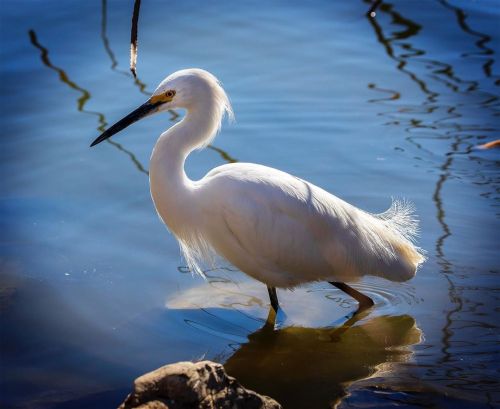#momentofzen
I was sitting by the water’s edge watching a cormorant gobble up fish after fish. Out of nowhere, this little snowy egret flew in and landed not five feet from me. I snapped a few quick photos then put my camera down to just watch them. It’s really neat how they shuffle their feet to stir up prey items. They caught a couple tiny fish, and then I quietly snuck away and left them to their morning hunting. #momentofzen #snowyegret #egrettathula #sepulvedabasin #sepulvedabasinwildlifereserve #sepulvedawildlifereserve
https://www.instagram.com/p/CZa2aAMLBT5/?utm_medium=tumblr
Post link
POV: floating under the sea, serenely drifting with the jellies.
Sit back and relax with these soothing jellies. From tiny delicate drifters, to giant deep-sea denizens, jellies come in a variety of beautiful and mesmerizing forms. There are many different kinds of gelatinous animals in the deep, but here we are featuring the umbrella-shaped animals that swim by pulsing a bell and usually have tentacles trailing behind their mellow flowing movement.
Floating along with one of the most remarkable residents of the deep sea—a Pantachogon haeckeli jelly.
There are only three known species of jellyfish in the genus Pantachogon. Sometimes called the cupcake jelly, we most often observe these tiny jellies from 1,000 to 2,000 meters (3,280 to 6,560 feet) deep in the Monterey Bay. We know very little about this species, but thanks to our remotely operated vehicles (ROVs), we can capture video footage of these incredible animals in their natural habitat. These videos and images let us capture the true magnificence of many delicate deep-sea animals so we can share them with you!
This individual was filmed by the ROV Doc Ricketts in the Monterey Bay at 873 meters (2,865 feet) deep.
A shimmery moment of zen ✨
The dazzling deep-sea dweller Beroe forskalii is a fierce predator. Comb jellies, or ctenophores, are gelatinous animals that swim by waving tiny hair-like projections called “ctenes.” Beroe also has tiny hairs along its wide mouth that act like teeth and help it grab onto its prey. When it bumps into another comb jelly, it holds on using these “teeth,” opens its mouth wide, and tries to swallow its prey whole.Monday moment of zen with the relaxing rhythm of our favorite gelatinous zooplankton. 〰️
Sit back and relax with these soothing jellies. From tiny, delicate drifters, to giant deep-sea denizens, jellies come in a variety of beautiful and mesmerizing forms. There are many different kinds of gelatinous animals in the deep, but here we are featuring the umbrella-shaped animals that swim by pulsing a bell and usually have tentacles trailing behind their mellow flowing movement. Most people underestimate the true diversity of this dazzling group of animals. Taxonomically, they are far more varied than a handful of the most common examples used to represent “jellyfish.”
Monday moment of zen with a little red jelly.
There are lots of little red jellies in the midnight zone, so many that it’s often difficult for researchers to tell them apart. MBARI scientists have spent years collecting and analyzing data to distinguish these species from one another based on their shape and form. In 2020, they developed a key to help scientists tell these look-alike species apart through their physical differences, depth distribution, and behavior. This little red jelly is Benthocodon pedunculatus, a species we often see bobbing just above the deep seafloor like little red UFOs.
And here it is, your Monday moment of zen. ✨
This rare glimpse of a juvenile king-of-the-salmon (Trachipterus altivelis) was captured on camera at 213 meters (about 700 feet) in Monterey Bay. Trachipterus are members of the ribbonfish group, aptly named for their thin, ribbon-like bodies. As these fish mature, they change dramatically from dark red to shiny silver and their frilled caudal and pelvic fins are greatly reduced. Because adult ribbonfishes spend most of their time in the ocean’s dark depths—generally around 900 meters or nearly 3,000 feet below the surface—sightings of this regal resident of the deep are uncommon.
When it feels like half your Facebook was invited to last night’s #SOLO premiere and you’re over here just trying to be one with the Force…
.
.
#momentofzen #naturetherapy #hiking #lunchhike #hansolo #theforce #mtfbwy #smuggler #bloodstripeleggings #geekfitness #geekstyle
An ode to salps.
Salps are gelatinous invertebrates that live in the open ocean but are closely related to the “sea squirts” (tunicates) seen in tidepools. They are found abundantly throughout the world’s ocean.
This species, Cyclosalpa bakeri, can form aggregates like the one pictured. The distinctive radial whorls up to 20 centimeters in diameter with about 12 individual zooids make them easy to identify. Each zooid has a pair of posterior end projections. This species is one of the more commonly encountered salps off coastal California. They tend to rise to the surface at night while spending daylight hours in deeper water.
Here it is, your Monday moment of zen—deep-sea holiday edition.

